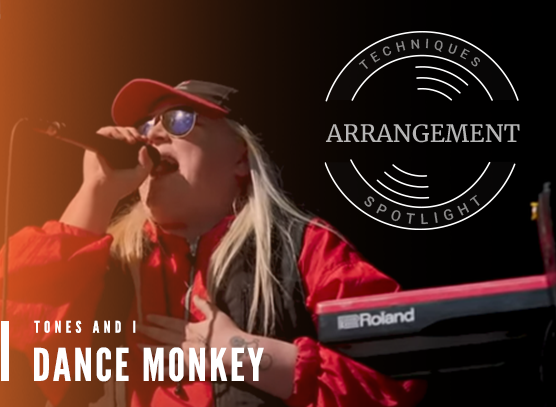Ask just about anyone what the main ingredients are in a mainstream hit, and the two that will most often come to mind are melody and lyrics. While their importance in a song’s success is undeniable, a super strong instrumental arrangement is equally necessary. Without it, even the most infectious melodies and engaging lyrics won’t reach their fullest potential.
Dance Monkey, the smash hit by Australian artist Tones and I, is a perfect case-in-point. While Tones and I’s uniquely infectious melodies and compelling lyrics certainly helped propel the song to the top spot on almost 40 charts around the world, its highly effective instrumental arrangement unquestionably bolstered the song’s impact. To put it best, Dance Monkey’s instrumental arrangement is in and of itself a masterclass on how to capitalize on trends, achieve a unique yet universally appealing vibe and create a dynamic and engaging listening experience that keeps the listener hooked and wanting more.
In this article, we look at how Dance Monkey’s instrumental arrangement serves the song where it counts the most – the chorus.
Chorus 1
The first chorus is arguably the most important chorus in any song. Why? Because it’s the section that officially “seals the deal” with the listener, determining whether they’ll continue listening or tune out. But in order to maximize the first chorus’s arrival, it needs to be musically set up long before its first downbeat is reached. This includes providing an engaging cross-section road to the chorus, as well as utilizing specific techniques to maximize its impact when it hits.
Dance Monkey employs two chorus impact accentuator techniques, the first happening smack in the middle of the first verse – an unlikely place. Following the groove development across the first six bars, the verse goes into breakdown mode in bars 7 and 8, which consist solely of two sustained acoustic piano whole notes. At this point, because of the breakdown’s placement at the end of an 8-bar section (which has been the most common verse section length over the last five years) and the popular technique of thinning out a verse arrangement just before the chorus hits, the listener is led to expect the chorus to directly follow this breakdown. However, the listener is instead “faked out” and hit not with the chorus, but with a continuation of the first verse across an entire second stanza. This effectively heightens their engagement as well as tension and anticipation for the impending chorus, which hits eight bars later than initially anticipated.
The second setup happens in the last bar of the verse, where a technique Hit Songs Deconstructed calls a Full Accompaniment Pull S.I.A. (Section Impact Accentuator) is employed. Here, the full accompaniment is pulled from the mix, achieving a few key things: it further heightens tension and anticipation for the chorus; it allows for Tones and I’s vocal pickup to further connect and resonate with the listener, effectively drawing them into the chorus; it maximizes the chorus’s impact through the dynamic contrast imparted; and it provides separation between two very instrumentally disparate sections.
Following the employment of this technique, the ensuing chorus turns the song on its head, breaking down to a revamped accompaniment consisting of a synth bass hook, four-on-the-floor kick, snaps and low-level hi hat, all making their first appearance in the song here. This, along with Tones and I’s vocals, creates an infectious, head-bobbing, minimalist groove that provides highly engaging cross-section contrast, while the repetition of the same chord progression from preceding sections maintains cross-section familiarity.
Additionally, in contrast to the more dynamic verse, the chorus’s accompaniment remains constant throughout the entirety of the section. This helps to reinforce the infectious bass groove with the listener, maintain danceability, and enable Tones and I’s unique vocals to connect with the listener without distraction from overly busy accompaniment.
Hit Songs Deconstructed subscribers can read the full article here (you must be logged into your PRO or Premiere account to access).
Not a Hit Songs Deconstructed subscriber? Click here to learn more about the Hit Songs Deconstructed platform.

